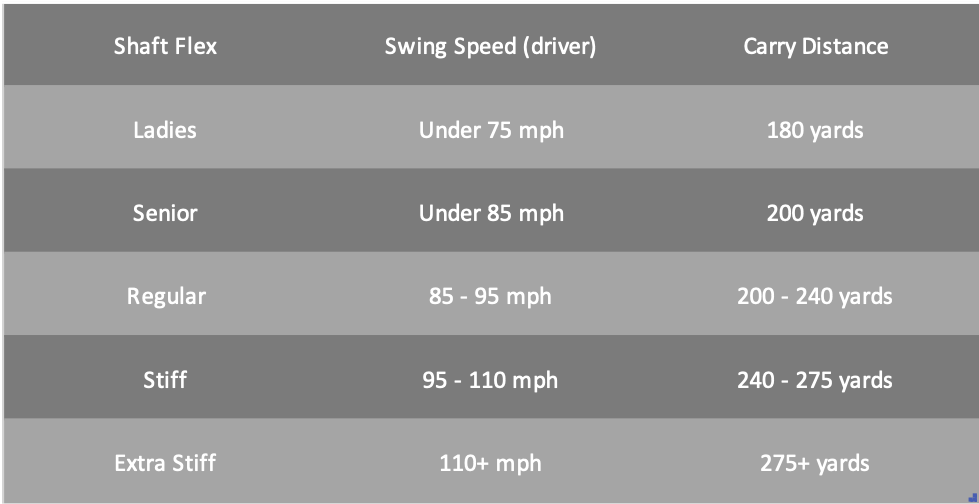Golf technology has progressed exponentially over the past two decades or so. We have moved well away from the wooden heads and shafts that dominated the game up until the 1970s. In fact, there were still wooden clubs being used on the PGA Tour as recently as 1997!
And then we entered the realm of the hi-tec as metal took over. Steel and graphite shafts, removable weights, carbon crowns and aerodynamic shapes. We have taken clubs to the furthest reaches of science to provide the ultimate in size, performance and forgiveness and yet we continue to go further.
But the point of this article isn’t to discuss the really complicated science or tech, we’re going to look at something quite straightforward. Shaft flex. We’ve all heard about regular and stiff shafts and we all have a general understanding of what they mean.
But do you know about what the recommended shaft flex is for various swing speeds? Do you know the benefits of having the right flex shaft and the drawbacks of having the incorrect shaft? No? Read on! (Even if the answer is yes, read on!!!)
What is shaft flex?
So what exactly is shaft flex? Quite simply it is the stiffness of the shaft and its ability to bend in response to the forces exerted by your swing. A very stiff shaft will only bend if high levels of force (fast swing) are exerted on it whereas a very flexible shaft will bend even if low levels of force (slow swing) are exerted on it.
Is it all about speed, speed and more speed?
Definitely not although swing speed plays a massive role. Just as no two golfers are the same, neither are any two golf swings. Tempo is also hugely important when deciding a shaft and someone who overswings may require a different flex to someone with a short, jerky swing.
Why is shaft flex important?
The flex is the most important part of any shaft. Yes, there are other elements that go into the shaft such as kick point, torque and length, but chief amongst all shaft attributes is the flex. Having the right flex will help to control trajectory, maximise distance and improve accuracy.
What if I have too soft a flex?
If you have too soft a flex, then the ball will launch too high which will result in lost distance. You are also more likely to see the ball tending towards a hook (going to the left for a right hander and the right for a left hander).
What if I have too stiff a flex?
The scenario for swinging with a shaft too stiff has the opposite effect yet the same result. Your ball will launch too low if the shaft is too stiff and thus you will lose distance as a result. You will also see the ball tending towards a slice (going to the right for a right hander and the left for a left hander).
What if I am in between flexes?
If you are between flexes, then the advice would be to go for the softer flex as this will be more forgiving.
What different flex shafts are there?
There are generally five different types of shaft. Ladies (L), Senior (A or M), Regular (R), Stiff (S), Extra Stiff (X).
Ladies (L)
Ladies shafts are the softest of the five types of shaft and is designed primarily for the female market who will have slower swing speeds. If you are swinging the club at under 75 mph and your driver carry distance translates as under 180 yards then this is the shaft for you.
Senior (A/M)
As people get older their swings get shorter, their speeds becomes reduced and they start losing distance. Moving to a Senior shaft when this happens will help maintain accuracy but also your distance.
Of course, there are other times too when it may be wise to switch from a regular shaft down to a senior shaft. For instance, if you have suffered an injury that has affected your swing speed and tempo then this may be something to look at.
The guideline is that if you swing speed is between 75 mph and 85 mph, equating to a carry distance of 180-200 yards, then this would be the shaft for you.
Regular (R)
This is the most common shaft flex and the one most of the golfers at your local club will play with. It is the standard bearer for any male starting golf before they move onto a different shaft that suits them better.
If you fit into the bracket of swinging between 85 and 95 mph and carrying your driver between 200 and 240 yards, then this is the right shaft for you.
Stiff (S)
Now we start to move into the higher-than-average swing speeds and carry distances. It’s no surprise to learn that there is a correlation between higher swing speed goes up and shot length to lower handicap, not that you should let your handicap dictate what shaft you use.
Anyone swinging the club at speeds of 95 mph to 110 mph and carrying their driver between 240 and 275 yards should look at a Stiff shaft.
Extra Stiff (X)
The stiffest shaft on this list is the Extra Stiff. There are stiffer shafts, but they are very uncommon and generally only used by the longest of hitters. Even Extra Stiff isn’t a very sought-after shaft and is still only used by the minority.
Anyone swinging the driver at over 110 mph and carrying it further than 275 yards should be using an Extra Stiff shaft.
Shaft Flex Chart

Understanding Your Swing
While many of us can look at the above shaft flex chart and pick out which shaft we need, others will not be able to do so. Perhaps they teeter on the edge of a regular and a stiff shaft, not sure which one would suit them better.
Our advice is to try out different shafts and see which ones give you the best numbers and feel. Of course, you may not have access to different shafts and sometimes it can be difficult to accurately judge distances at a driving range.
Then we recommend Custom Fitting. Not only will you figure out how fast you are swinging it, but you will also learn about your swing and optimize your club for peak performance. For instance, if you are carrying the ball 230 yards with a regular flex, you may discover that a few simple changes to kickpoint and flex may result in your carrying it 250 yards! This would result in a change in shaft that you were never expecting!!!
The End
Yes, that is sadly the end of the article. We hope you enjoyed reading it as much as we enjoyed writing it. If you would like to keep up to date with all of our updates and content, then please follow us on Facebook and on Instagram. We look forward to seeing you there!
Happy Golfing,
The Halpenny Golf Team

 Hate
Hate
 Dislike
Dislike
 Neutral
Neutral
 Like
Like
 Love
Love



































